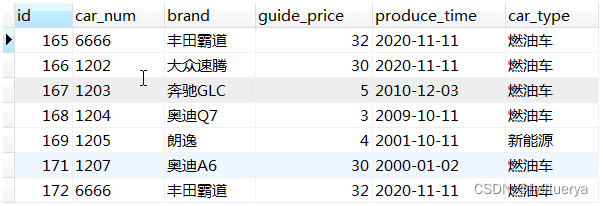实体类Car:
package com.bjpowernode.domain;
public class Car {
private Integer id;
private String carNum;
private String brand;
private Double guidePrice;
private String produceTime;
private String carType;
//构造方法略
//setter and getter 略
//toString略
数据库中的t_car表:

在MyBatis核心配置文件中开启驼峰命名自动映射
<settings>
<setting name="mapUnderscoreToCamelCase" value="true"/>
</settings>
开启多条件查询:(查询条件有可能是:0、1、2、3...条)
if标签:
持久层接口中
/**
* 根据多条件查询Car
* @param brand
* @param guidePrice
* @param carType
* @return
*/
List<Car> selectByIf(@Param("brand") String brand, @Param("guidePrice") Double guidePrice,
@Param("carType") String carType);
sql映射文件中
<select id="selectByIf" resultType="car">
select * from t_car where 1=1
//下行代码中test属性值里的brand源自持久层接口中方法里形参前面@Param()设定的值
<if test="brand != null and brand != ''">
//下行代码中like前面的brand源自数据库表中的字段名,#{}里面的brand与上行代码中的brand相同
and brand like #{brand}"%"
</if>
<if test="guidePrice != null and guidePrice != ''">
and guide_price >= #{guidePrice}
</if>
<if test="carType != null and carType != ''">
and car_type = #{carType}
</if>
</select>
使用if标签需要注意以下几点:
1、if标签中test属性是必须的,其属性值为布尔类型false或true
true表示if标签中的sql语句会自动拼接;false表示if标签中的sql语句不会拼接
2、test属性值中的写法:
1)如果持久层接口中方法里的形参使用了@Param注解,那么test中写的是@Param注解指定的参数名。上面例子中就是这种情况。
2)如果没有使用@Param注解,那么test中要出现的是:param1、param2...或 arg0、arg1…
3)如果持久层接口中方法里的形参使用了POJO,那么test中出现的是POJO类的属性名。
3、主sql中where关键字后面为什么写了1=1这个表达式?
回答:当所有的if标签里test的属性值都是false时,如果没有这个恒成立的表达式,关键字where后面就没有内容了,这就是一条非法的sql语句了,有了这个恒成立的条件,就不会出现非法sql语句的情况。
4、在mybatis的动态SQL当中,不能使用'&&',只能使用'and'。
where标签:
where标签的作用:
1、让where子句更加动态智能。使用where标签后主sql语句中不再需要像0=0这样恒成立的条件
2、所有条件都为空时,where标签保证不会生成where子句。
3、自动去除某些条件前面多余的and或or。后面的多余条件不能去除。
持久层接口中
/**
* 根据多条件查询Car,使⽤where标签
* @param brand
* @param guidePrice
* @param carType
* @return
*/
List<Car> selectByWhere(@Param("brand") String brand, @Param("guidePrice") DoubleguidePrice,
@Param("carType") String carType);
sql映射文件中
<select id="selectByWhere" resultType="car">
select * from t_car
<where>
<if test="brand != null and brand != ''">
and brand like #{brand}"%"
</if>
<if test="guidePrice != null and guidePrice != ''">
and guide_price >= #{guidePrice}
</if>
<if test="carType != null and carType != ''">
and car_type = #{carType}
</if>
</where>
</select>
trim标签
trim标签的属性:
prefix:在trim标签中的语句前添加内容
suffix:在trim标签中的语句后添加内容
prefixOverrides:前缀覆盖掉(去掉)
suffixOverrides:后缀覆盖掉(去掉)
持久层接口中
/**
* 根据多条件查询Car,使⽤trim标签
* @param brand
* @param guidePrice
* @param carType
* @return
*/
List<Car> selectByTrim(@Param("brand") String brand, @Param("guidePrice") Double guidePrice,
@Param("carType") String carType);
sql映射文件中
<select id="selectByTrim" resultType="car">
select * from t_car
<trim prefix="where" suffixOverrides="and|or">
//下行代码中的test属性值中的brand源自持久层接口中方法里@Param()设定的值
<if test="brand != null and brand != ''">
//下行代码中的第一个brand源自数据库表中的字段名,#{}里面的brand与上行代码中的brand相同
brand like #{brand}"%" and
</if>
<if test="guidePrice != null and guidePrice != ''">
guide_price <= #{guidePrice} and
</if>
<if test="carType != null and carType != ''">
car_type = #{carType}
</if>
</trim>
</select>
set标签
主要使用在update语句当中,用来生成set关键字,同时去掉最后多余的“,”
比如我们只更新提交的不为空的字段,如果提交的数据是空或者"",那么这个字段我们将不更新。
持久层接口中
/**
* 更新信息,使⽤set标签
* @param car
* @return
*/
int updateBySet(Car car);
sql映射文件中
<update id="updateWithSet">
update t_car
<set>
//下行代码中test属性值里面的carNum源自实体类Car的属性名
<if test="carNum != null and carNum != ''">
//下行代码中的car_num是数据库表中的字段名,花括号中的carNum是实体类Car的属性名
car_num = #{carNum},
</if>
<if test="brand != null and brand != ''">
brand = #{brand},
</if>
<if test="guidePrice != null and guidePrice != ''">
guide_price = #{guidePrice},
</if>
<if test="produceTime != null and produceTime != ''">
produce_time = #{produceTime},
</if>
<if test="carType != null and carType != ''">
car_type = #{carType},
</if>
</set>
where id = #{id}
</update>
choose when otherwise 标签
这三个标签是在一起使用,其语法格式是:(只有一个分支被执行)
<choose>
<when></when>
<when></when>
<when></when>
<otherwise></otherwise>
</choose>
这三个标签的使用相当于:
if(){
}else if(){
}else if(){
}else if(){
}else{
}
持久层接口中
/**
* 使用choose when otherwise标签查询
* @param brand
* @param guidePrice
* @param produceTime
* @return
*/
List<Car> selectByChoose(@Param("brand") String brand, @Param("guidePrice") Double guidePrice,
@Param("produceTime") String produceTime);
sql映射文件中
<select id="selectWithChoose" resultType="car">
select * from t_car
<where>
<choose>
//下行代码中test的属性值中的brand源自持久层接口中方法里形参前面@Param中设定的值
<when test="brand != null and brand != ''">
//下行代码中第一个brand源自数据库表中的字段名,花括号中的brand源自持久层接口中方法里的形参名
brand like #{brand}"%"
</when>
<when test="guidePrice != null and guidePrice != ''">
guide_price >= #{guidePrice}
</when>
<otherwise>
produce_time >= #{produceTime}
</otherwise>
</choose>
</where>
</select>
foreach标签
循环数组或集合,动态生成sql,比如这样的SQL:
批量删除:
delete from t_car where id in(1,2,3);
delete from t_car where id = 1 or id = 2 or id = 3;
1)使用含有'in'的sql语句进行删除
在持久层接口中
/**
* 通过foreach完成批量删除
* @param ids
* @return
*/
int deleteBatchByForeach(@Param("ids") Long[] ids);
在映射文件中
<!--
collection:集合或数组
item:集合或数组中的元素
separator:集合或数组中元素的分隔符
open:foreach标签中所有内容的开始
close:foreach标签中所有内容的结束
-->
<delete id="deleteByForeach">
delete from t_car where id in
//下行代码中的collection的属性值源自持久层接口中方法的形参之前的@Param中设定的值
<foreach collection="ids" item="id" separator="," open="(" close=")">
//下行代码中花括号里面的id源自上行代码中item的属性值
#{id}
</foreach>
</delete>
测试代码
@Test
public void testDeleteByForeach(){
SqlSession sqlSession = SqlSessionUtil.openSession();
StudentMapper mapper = sqlSession.getMapper(StudentMapper.class);
int count = mapper.deleteByForeach(new Long[]{40L, 41L, 42L});
System.out.println("删除记录条数是:" + count);
sqlSession.commit();
sqlSession.close();
}
2)使用含有'or'的sql语句进行删除
在持久层接口中
/**
* 通过foreach完成批量删除
* @param ids
* @return
*/
int deleteByForeach2(@Param("ids") Long[] ids);
在映射文件中
<delete id="deleteByForeach2">
delete from t_car where
//下行代码中的collection的属性值源自持久层接口中方法的形参之前的@Param中设定的值
<foreach collection="ids" item="id" separator="or">
//下行代码中花括号里面的id源自上行代码中item的属性值
id = #{id}
</foreach>
</delete>
测试代码
@Test
public void testDeleteByForeach2(){
SqlSession sqlSession = SqlSessionUtil.openSession();
CarMapper mapper = sqlSession.getMapper(CarMapper.class);
Long[] ids = {158L,159L,160L};
int count = mapper.deleteByForeach2(ids);
System.out.println(count);
sqlSession.commit();
sqlSession.close();
}
批量添加
在持久层接口中
/**
* 批量添加,使⽤foreach标签
* @param cars
* @return
*/
int insertByForeach(@Param("cars") List<Car> cars);
在映射文件中
<insert id="insertByForeach">
insert into t_car values
//下行代码中的collection的属性值源自持久层接口中方法的形参之前的@Param中设定的值
<foreach collection="cars" item="car" separator=",">
//下行代码中的car源自上行代码中item的值
(null,#{car.carNum},#{car.brand},#{car.guidePrice},#{car.produceTime},#{car.carType})
</foreach>
</insert>
测试代码
@Test
public void testInsertByForeach(){
SqlSession sqlSession = SqlSessionUtil.openSession();
CarMapper mapper = sqlSession.getMapper(CarMapper.class);
Car car1 = new Car(null,"1200", "比亚迪秦", 30.0, "2021-11-23", "新能源");
Car car2 = new Car(null,"1201", "比亚迪宋", 33.0, "2022-10-11", "新能源");
Car car3 = new Car(null,"1202", "比亚迪汉", 35.0, "2023-06-22", "新能源");
List<Car> cars = new ArrayList<>();
cars.add(car1);
cars.add(car2);
cars.add(car3);
mapper.insertBatch(cars);
sqlSession.commit();
sqlSession.close();
}
























 137
137

 被折叠的 条评论
为什么被折叠?
被折叠的 条评论
为什么被折叠?








